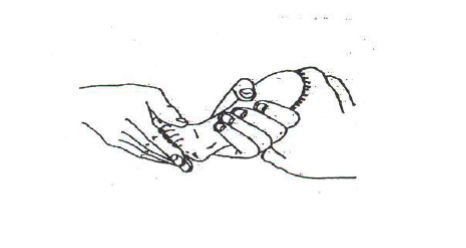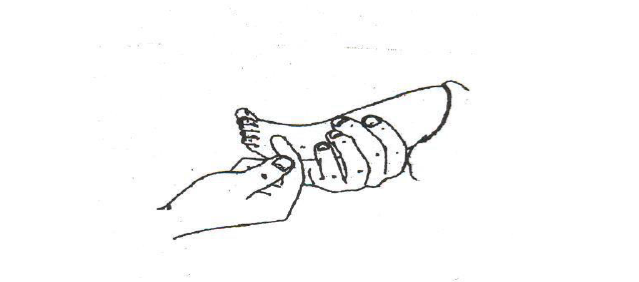What is positional talipes equinovarus?
Talipes – this is when the typical position of one or both feet is abnormal
Equino – this is when the foot points downwards
Varus – this is when the foot is also turned inwards
Why have I been given this leaflet?
The doctor on the ward has seen your baby and feels that the foot position is not as it should be. This might be one or both feet. This is often called Talipes Equinovarus or Talipes for short. It is thought to be caused by the baby not having room to stretch its feet in the last weeks of pregnancy. It is normally a temporary condition and corrects itself once the baby has been born and has room to move. This may be quite quickly or it may take a little time.
You may not need physiotherapy help and the doctor will show you what to do. If the doctor feels some help and advice is needed, they will send a referral to us. We will see you when your baby is approximately two weeks old. The doctor will have shown you some simple things to do to help your baby before we see you. They will give you this leaflet to remind you of that early advice. If the doctor feels that your child’s foot/feet need more help than physiotherapy, they will refer
you to the orthopaedic team.
If you have not heard from us within two weeks of returning home and your doctor told you they were referring to us, please give us a ring and we will check that the referral has been received.
What can I do to help my baby?
It is good to begin exercises as soon as possible. They will help to stretch the foot and stimulate the inactive muscles.
Repeat the following activities throughout the day about 10 times. Nappy change and feeding times are good times. The doctor on the ward will have shown you how to do this before you leave.

With your baby’s knee bent, hold with one hand around the calf.
With your other hand, hold across the foot, your thumb on the top and fingers below.
Move the forefoot so that it is straight, in line with the leg, then move the foot and ankle up and then down.
Repeat this 10 times. On the 10th time, hold the foot in the up position gently for 10 seconds.

It will also be helpful to tickle and stroke your baby’s foot in different places, particularly the outside of your baby’s feet. This will encourage your baby to move their feet in all directions.
Points to remember
- always stretch the foot very gently
- having a regular routine for exercises, for example doing them at nappy changes
- do not do the exercises immediately after feeding as your baby may feel sick
- as able keep you baby’s feet free from tight clothing allowing movement
How often will I see my physiotherapist?
The physiotherapist will discuss this with you after they has seen your baby. The physiotherapist will give you any advice on what you should do and will check to ensure that you are able to do the stretches with your baby. They will then review progress with you at one month and then again at three months of age.
What if I have any queries?
You can discuss any queries with your physiotherapist. Please ring them on the number below and leave a message for them if they are not available when you ring.
Should you have any queries before your first appointment, please ring the number below and ask to speak to the clinical team manager.
Community Paediatric Physiotherapy
Community Business Unit
Bensham Hospital
Gateshead
NE8 4YL
Tel: 0191 445 3124
Mon – Fri: 08.00 – 16.30
Data Protection
Any personal information is kept confidential. There may be occasions where your information needs to be shared with other care professionals to ensure you receive the best care possible.
In order to assist us to improve the services available, your information may be used for clinical audit, research, teaching and anonymised for National NHS Reviews and Statistics.
Further information is available via Gateshead Health NHS Foundation Trust website (Terms and conditions – QE Gateshead) or by contacting the Data Protection Officer by telephone on 0191 445 8418 or by email [email protected].
This leaflet can be made available in other languages and formats upon request.